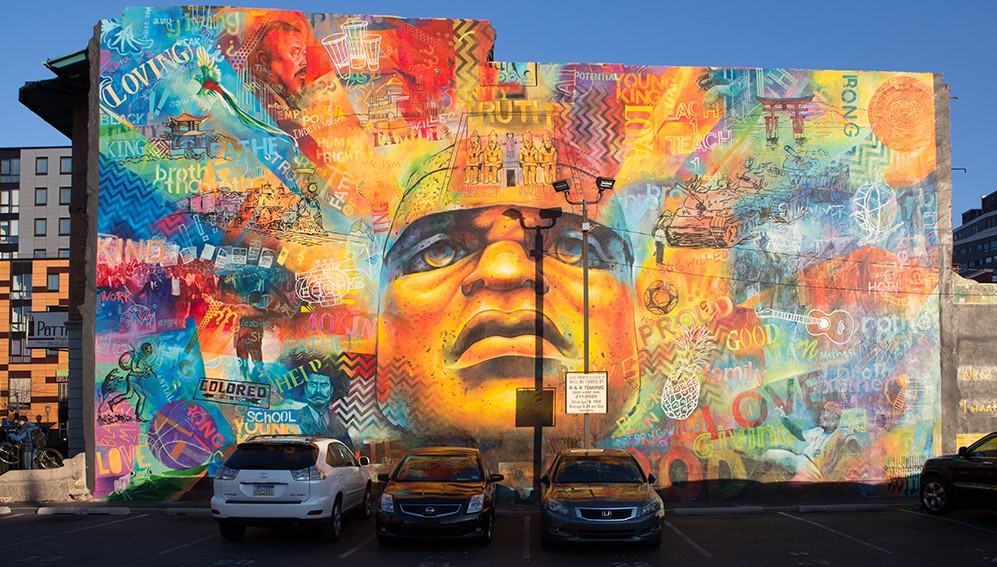The Philadelphia Museum of Art is usually nearly silent, with just the sound of footsteps and quiet remarks between art-going companions. But on one Wednesday in March, its galleries were lit up with noise, a veritable cacophony of singing, chanting, hand clapping and stomping. It started small, with about 25 people leading an event called “Push/Pull: A Procession of Healing,” organized by Amber Art and Design, meant to mark the 35th anniversary of the MOVE Bombing in West Philadelphia. But it attracted more and more patrons who heard the sounds, grew curious, and joined in; by the time the procession wound its way through the main galleries, the group had grown to more than 250 people.
“It was a release of frustrations that we are still feeling about that terrible event from long ago,” says Ernel Martinez, one of the event’s organizers, who notes that those assembled that night represented a diverse cross-section of Philadelphia, including many young people and people of color, populations the PMA has historically found hard to reach. “It was very emotional.”

Martinez is one of the founders of Amber Art and Design, a collective of five artists who individually and together make bold public art projects that engage historically disempowered communities in the Philadelphia area. The PMA procession, which included performers wearing gas masks and protective gear, as well as the simple gardening clothes of the victims, was meant to explore how the community of West Philadelphia has been shaped by the MOVE bombing, and its resilience in the aftermath of those events.
“There is a component of activism in our work,” says Martinez. “It’s about sharing and demystifying the process of making art and giving tools for voices of the community to be heard in spheres where they usually aren’t heard.”
The Port Richmond-based collective is a diverse mix of native Philadelphians and devoted transplants, all of whom have set down deep roots in different city neighborhoods during the nearly five years they have been together. All five artists have made mural making one of their specialties and have worked extensively with the City of Philadelphia Mural Arts Program; they are best known for creating The Roots mural at Broad and South streets. Originally, they joined together so they could have a space big enough to work on the huge mural panels. But they’re not just muralists. Instead, they employ a multidisciplinary approach to public art—performance pieces like the PMA procession, collaborations with art and social change organizations to create special events, interactive exhibitions, and yes, murals, with a twist.
Beyond this, they are united by a common vision: a belief that the best art does not sit passively on a wall, but rather interacts with people, becoming a dynamic part of a place and community, exploring some of the hardest and deepest questions of our lives—race, class, poverty, and inequality.
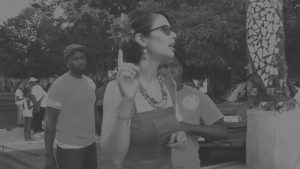
“There is a component of activism in our work,” says Martinez. “It’s about sharing and demystifying the process of making art and giving tools for voices of the community to be heard in spheres where they usually aren’t heard.”
The artists who make up Amber Art are among the few people of color making socially-engaged art in Philadelphia. Besides Martinez, who has painted several murals in the city, the group includes Keir Johnston; Charles Barbin; Willis Nomo; and multimedia artist (and the only woman) Linda Fernandez. Each of them has been doing this kind of work for ten plus years, which gives them the freedom to take risks. But it’s their shared insight into the lived experiences of Philadelphians that makes Amber Art’s work feel so intimate.
“We work with the demographics that we come from, men and women of color,” says Martinez. “We come from these communities, we live in these communities.”
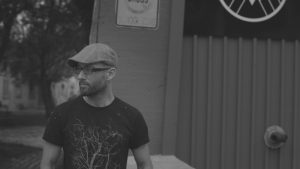
In another recent work, a one-night performance at Pennsylvania Acadamy of Fine Arts called La Frontera (part of a longer work by the same name for Open Source), artists from Amber Art used scrap wood to create a series of banquet tables and podiums and staged a dinner meant to simulate the experience of eating in at your local corner store or restaurant. They invited members of many different communities, including fellow artists, undergrads from Ursinus, and residents of North Kensington. Monica Zimmerman, Director of Museum Education at PAFA, says the event brought people into PAFA who might not normally attend their events, and made them feel comfortable and engaged. A big part of this was food: Amber Art artists served participants foods from many different cultures that can be found within our city, including Eritrean, Korean, and American Southern.
“We don’t believe art is a panacea for what ails this wonderful city we call home,” Martinez said in an interview with the Philadelphia Museum of Art. “Yet, it can be a harbinger for conversation and ultimately lead to some kind of change.”
“The corner store is a neighborhood pilar in the community,” Zimmerman says… “The artists were trying to get participants to think about Philly as a series of neighborhoods they know and don’t know. Trying to get them to explore. Go to the corner store in north Kensington and eat something, it’s fine.”
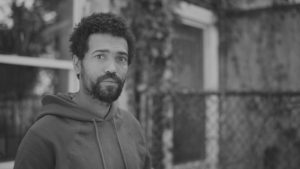
The night featured spoken word poetry, music, and impromptu performances in which artists and musicians solicited thoughts and stories from audience members and turned them into poems and songs on the fly. “A lot of people who normally would not meet on a street corner or in a museum had dinner together,” Zimmerman says.
Amber Art artists have also shown themselves to be leaders in the conversation around using art to put questions of race in the public’s consciousness. After all, art has historically been an extremely powerful tool in bringing people to the table to think deeply across divides.
“We don’t believe art is a panacea for what ails this wonderful city we call home,” Martinez said in an interview with the Philadelphia Museum of Art. “Yet, it can be a harbinger for conversation and ultimately lead to some kind of change.”
A recent mural, “Building Brotherhood: Engaging Males of Color,” which was unveiled at 4008 Chestnut Street on Monday, encapsulates this approach. Laure Biron, the program director of Mural Arts’ Porch Light Program, which helped fund the project, says the goal of the project was to ask the question, “What obstructions are there for men and boys of color to gaining access to education and employment?” Amber Art Artists held a series of town hall meetings in different neighborhoods around the city to investigate this question with men of color—including Asian and Latino men and boys—from all over the city.
At these meetings, men brought up police brutality, the myth of the “model minority” for Asian men, mass incarceration, and much more. The Amber Art’s design reflected this community input. The resulting mural features a kind of patchwork effect, a headdress around a head with figures and symbols of many historical events and cultural figures that affect men of color.
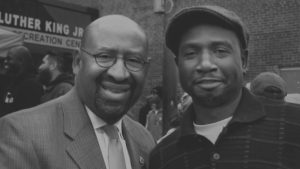
“I think they have a really beautiful way of speaking about race,” Biron says. “Those are really tough issues to talk about and they do so sort of effortlessly. The community’s really excited about it. They see themselves and their history and their families captured in it.”
This success is again the result of Amber’s thoughtful approach: The artists that make up Amber Art come into communities in which they want to make art as equal partners with community members, rather than approaching communities with pre-set project ideas. Further, Amber Art artists are intimately familiar with their forebearers, people who have been doing community art forever, including the black art movement from Harlem in the 60s.
This affords Amber Art artists deep insight into the communities they are trying to engage with their work. “We don’t think of these communities as marginalized. We feel these communities are empowered, and we want to use art as a tool of expressing that power.”
Header Photo: Building Brotherhood Mural © 2015 City of Philadelphia Mural Arts Program / Keir Johnston & Willis Humphrey. Photo by Steve Weinik.



